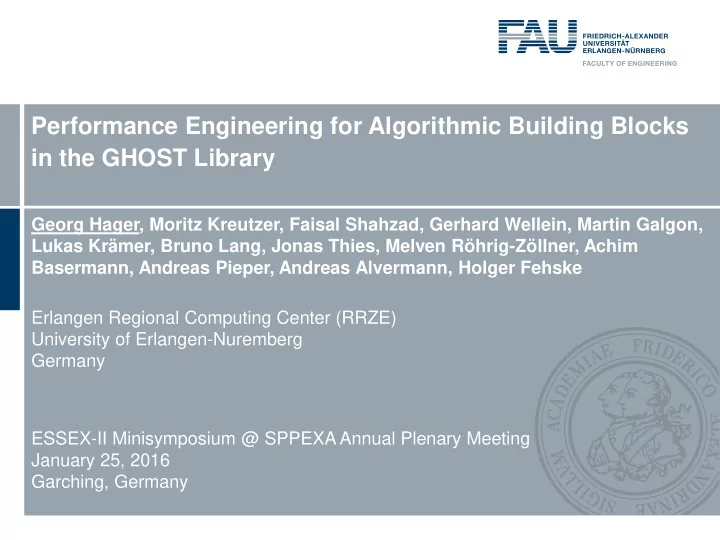

Performance Engineering for Algorithmic Building Blocks in the GHOST Library Georg Hager, Moritz Kreutzer, Faisal Shahzad, Gerhard Wellein, Martin Galgon, Lukas Krämer, Bruno Lang, Jonas Thies, Melven Röhrig-Zöllner, Achim Basermann, Andreas Pieper, Andreas Alvermann, Holger Fehske Erlangen Regional Computing Center (RRZE) University of Erlangen-Nuremberg Germany ESSEX-II Minisymposium @ SPPEXA Annual Plenary Meeting January 25, 2016 Garching, Germany
Outline Performance Engineering (PE) The GHOST library Work planned for ESSEX-II
The whole PE process at a glance
Example: KPM Kernel Polynomial Method • Compute spectral properties of quantum system (Hamilton operator) • Approximation of full spectrum • Naïve implementation: SpMVM + several BLAS-1 kernels Building blocks: Application: Loop over random initial states (Sparse) linear algebra library Algorithm: Loop over moments Sparse matrix vector multiply Scaled vector addition Vector scale Scaled vector addition Augmented Sparse Vector norm Matrix Vector Multiply Augmented Sparse Matrix Dot Product Multiple Vector Multiply
Step 1 : naïve augmented (fused) kernel • Naïve kernel is clearly memory bound • Better resource utilization • B C = 3.39 B/F 2.23 B/F • Still memory bound same pattern Step 2 : augmented blocked • Augmented kernel is memory bound • R = # of random vectors • B C = 2.23 B/F (1.88/R + 0.35) B/F • Decouples from main memory BW Performance portability becomes well defined!
What about the decoupled model? Why does it decrease? Ω = 𝐵𝑑𝑢𝑣𝑏𝑚 𝑒𝑏𝑢𝑏 𝑢𝑠𝑏𝑜𝑡𝑔𝑓𝑠𝑡 𝑁𝑗𝑜𝑗𝑛𝑣𝑛 𝑒𝑏𝑢𝑏 𝑢𝑠𝑏𝑜𝑡𝑔𝑓𝑠𝑡
The GHOST library General Hybrid Optimized Sparse Toolkit M. Kreutzer et al.: GHOST: Building blocks for high performance sparse linear algebra on heterogeneous systems. Preprint arXiv:1507.08101
GHOST design guidelines • Strictly support the requirements of the project • Enable fully heterogeneous operation • Limit automation • Do not force dynamic tasking • Do not force C++ or an entirely new language • Stick to the well- known “MPI+X” paradigm • Support data parallelism via MPI+X • Support functional parallelism via tasking • Allow for strict thread/process-core affinity
Task parallelism: Asynchronous checkpointing with GHOST tasks Parent task CP_obj : • void* to object of ckpt_t type • ckpt_t class is defined by programmer • checkpoint object contains the ghost_task_create( ckpt_task_ptr,& asynchronous copy of the checkpoint CP_func, CP_obj ,…) Checkpoint task update_CP(CP_obj); // async. copy of CP is updated iterative ghost_task_wait(ckpt_task_ptr); CP_func() ghost_task_enqueue(ckpt_task_ptr); // This function takes an updated copy of CP_obj as argument and writes to PFS
Heterogeneous performance? 0.5 Pflop/s The need for hand-engineered kernels Block vector times small matrix performance of GHOST and existing BLAS libraries ( tall skinny ZGEMM )
SELL-C- σ Performance portability for SpMVM
Constructing SELL-C- σ Width of chunk 𝑗 : 𝑚 𝑗 Pick chunk size 𝐷 (guided by 1. SIMD/T widths) Pick sorting scope 𝜏 2. 3. Sort rows by length within Sorting scope 𝜏 each sorting scope 4. Pad chunks with zeros to make them rectangular Store matrix data in “chunk 5. column major order” Chunk size 𝐷 “Chunk occupancy”: fraction 6. of “useful” matrix entries 𝑂≫𝐷 1 𝛾 worst = 𝑂 + 𝐷 − 1 𝐷𝑂 𝐷 𝑂 𝑜𝑨 𝛾 = 𝑂 𝑑 𝐷 ⋅ 𝑚 𝑗 SELL-6-12 𝑗=0 β =0.66
What is performance portability?
ESSEX-II and GHOST
1. Building blocks development • Improved support for mixed precision kernels • Fast point-to-point sync on many-core • High-precision reductions • (Row-major storage TSQR) • Full support for heterogeneous hardware (CPU, GPGPU, Phi) 2. Optimized sparse matrix data structures • Identify promising candidates (ACSR, CSX) • Exploiting matrix structure: symmetry, sub-structures 3. Holistic power and performance engineering • Comprehensive instrumentation of GHOST library functions • ECM performance modeling of SpMMVM and others • Energy modeling of building blocks • Performance modeling beyond the node 4. Comprehensive documentation
J. Hofmann, D. Fey, J. Eitzinger, G. Hager, G. Wellein: Performance analysis of the Kahan- enhanced scalar product on current multicore processors. Proc. PPAM2015. arXiv:1505.02586 Example: performance impact of the Kahan-augmented dot product float sum = 0.0, c = 0.0; float sum = 0.0; for (int i=0; i<N; ++i) { for (int i=0; i<N; i++) { float prod = a[i]*b[i]; sum = sum + a[i] * b[i] float y = prod-c; } float t = sum+y; c = (t-sum)-y; 4 ADD, 1 MULT 1 ADD, 1 MULT sum = t; } IVB (SP) • No impact of Kahan if any SIMD is applied • Compilers do not cut the cheese • Method adaptable to other applications (e.g., other high- precision reductions, data corruption checks)
Example: Energy analysis of KPM • Time to solution has IVB lowest-order impact on 2.2 GHz energy • Tailored kernels are key to performance (4.5x in runtime & energy) • Energy-performance models yield correct qualitative insight • Future: Large-scale 2 𝑔 2 𝐹(𝑜) = 𝐺 ∙ 𝑋 00 + 𝑜 𝑋 01 + 𝑋 1 𝑔 + 𝑋 energy analysis & modeling min(𝑜𝑄 0 𝑔 , 𝑄 max ) Energy-performance model
Download our building block library and applications: http://tiny.cc/ghost General, Hybrid, and Optimized Sparse Toolkit Thank you.
Recommend
More recommend